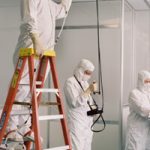 If you’re maintaining a USP 797 compliant cleanroom, you’re required to have written cleaning STandard Operating Procedures (SOPs) and cleaning logs. Your SOP should include when to clean, how to clean, and what to clean with. Here are some guidelines on these categories.
If you’re maintaining a USP 797 compliant cleanroom, you’re required to have written cleaning STandard Operating Procedures (SOPs) and cleaning logs. Your SOP should include when to clean, how to clean, and what to clean with. Here are some guidelines on these categories.
How Often?
Surfaces of sterile compounding areas need to be cleaned with the most frequency. In cemag.us’s article, “Cleaning Protocols for USP 797 Compliance,” Karen Bonnell writes, “It is required that the surfaces of BSCs, CAIs, CACIs, and LAFWs be cleaned and disinfected at the beginning of each shift, before each batch of product is compounded, not longer than 30 minutes following the previous surface disinfection when ongoing compounding activities are occurring, after spills, and when surface contamination is known or suspected.”
Daily cleaning and disinfecting duties include: counters, work surfaces, and floors (in all areas.) Be sure to only mop when there is no compounding in progress.
Monthly cleaning (at minimum) includes all other surfaces, ceilings, walls, shelving, and carts. These processes should also occur when there is no compounding in progress.
Cleaning Procedures
Cross-contamination is a concern with cleaning the wrong way, so it is best to clean from top to bottom, dry to wet, and from cleanest to dirtiest. Bonnell suggests: “In a monthly cleaning, the order would be: ceilings; walls and windows; exteriors of process equipment and cabinets; countertops and other horizontal surfaces; and at last, floors.”
When using wipers (see reachable surfaces), Bonnell explains, “Wipers should be folded so that the entire surface of the wiper can be used. Typically wipers are quarter folded, and then refolded after every wipe of the surface, to contain and remove the contamination. In this manner, there are eight different surfaces of the wiper exposed and able to be used for wiping. Wiping should be done in overlapping linear strokes from clean to dirty or dry to wet. After all eight surfaces have been used, the wiper (and its captured contamination) should be discarded in an appropriate container.”
When cleaning the floors, remember that the corners furthest away from the entry doors are the cleanest, so start there and move towards the higher-trafficked areas. Mop in overlapping linear strokes.
What to Clean With
Your choice of cleaning equipment depends on what you are cleaning. Here is a rundown of what to use:
- • For reachable surfaces: Use low-linting wipers and solutions that are appropriate for your environment. Check which materials and solvents are approved for your particular class of cleanroom. Wipers should not be so wet that they are dripping with solution.
- • Floors: Floor mops may be flat using a bucketless system, or made of tubular knitted yarn and used with 2-3 buckets. It is necessary to use more than one rinse bucket to ensure that dirt does not go back on the floor. For bucketless systems, mops are either pre-wetted or sprayed with a solution.
- • Difficult to reach surfaces: Mop-like tools are made for those surfaces out of your reach. They are isolator cleaning tools, and you use them with replaceable mop covers.
- • Tight areas: For vents, junctions, dimples, and the like, use a swab wetted with a cleaning solution, IPA, or sterile water to clean these tight spaces.
Training is just as important as implementing your SOP. You will want to not only train and test personnel before they begin work in the cleanroom; you also want to schedule regular re-trainings. Make sure your written SOP is always available to personnel. Finally, using charts, checklists, and training posters will help operators retain the information.
Gerbig Cleanrooms performs certification and validation of cleanrooms. We also build quality Airecell cleanrooms. For questions about equipment, processes, or construction, contact us at 888-628-0056 or info@gerbig.com.